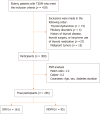Correlation between diabetic peripheral neuropathy and thyroid hormone sensitivity in elderly patients with type 2 diabetes mellitus
- PMID: 39959265
- PMCID: PMC11718484
- DOI: 10.4239/wjd.v16.i2.98897
Correlation between diabetic peripheral neuropathy and thyroid hormone sensitivity in elderly patients with type 2 diabetes mellitus
Abstract
Background: Diabetic peripheral neuropathy (DPN) is a common complication of type 2 diabetes mellitus (T2DM), significantly affecting patients' quality of life and imposing a substantial economic burden. Recent studies have highlighted the role of thyroid hormones in diabetes complications, particularly in elderly patients with T2DM. However, the relationship between thyroid hormone sensitivity and DPN remains unclear.
Aim: To investigate the correlation between thyroid hormone sensitivity and DPN in elderly patients with T2DM.
Methods: In a cohort of 256 elderly patients with T2DM, propensity score matching was used to balance age, sex, and diabetes duration. Clinical data were collected to calculate thyroid hormone sensitivity and analyze its correlation with DPN. A random forest model was used to evaluate the diagnostic value of free triiodothyronine/free thyroxine (FT3/FT4) for DPN.
Results: Patients with DPN had a lower FT3/FT4 ratio [ (0.302 ± 0.053) vs (0.316 ± 0.049), P = 0.040]. Quartile stratification showed decreasing DPN prevalence with higher FT3/FT4 ratios. Spearman's correlation analysis showed that a lower FT3/FT4 ratio was associated with higher glycated hemoglobin, fasting blood glucose, reduced nerve conduction velocity, and electrical skin conductance. Logistic regression indicated a positive relationship between the median FT3/FT4 ratio and bilateral foot electrochemical skin conductance [odds ratio (OR): 1.019; 95%CI: 1.005-1.034; P = 0.007] and sural nerve sensory amplitude (OR: 1.310; 95%CI: 1.008-1.703; P = 0.043). Receiver operating characteristic analysis using a random forest model showed that incorporating FT3/FT4 improved predictive performance for DPN, with an area under the curve of 0.74, sensitivity of 0.79, specificity of 0.64, and accuracy of 0.77.
Conclusion: In elderly patients with T2DM with euthyroidism, a lower FT3/FT4 ratio is correlated with increased DPN incidence, affecting both large and small nerve fibers. FT3/FT4 is an effective predictor of DPN.
Keywords: Diabetic peripheral neuropathy; Elderly; Free triiodothyronine/free thyroxine ratio; Thyroid hormone sensitivity; Type 2 diabetes mellitus.
©The Author(s) 2025. Published by Baishideng Publishing Group Inc. All rights reserved.
Conflict of interest statement
Conflict-of-interest statement: All the authors report no relevant conflicts of interest for this article.
Figures


Similar articles
-
Correlation of thyroid-related hormones with vascular complications in type 2 diabetes patients with euthyroid.Front Endocrinol (Lausanne). 2022 Nov 18;13:1037969. doi: 10.3389/fendo.2022.1037969. eCollection 2022. Front Endocrinol (Lausanne). 2022. PMID: 36465631 Free PMC article.
-
Correlation between thyroid hormone sensitivity and diabetic peripheral neuropathy in euthyroid patients with type 2 diabetes mellitus.Sci Rep. 2024 Aug 23;14(1):19603. doi: 10.1038/s41598-024-70673-3. Sci Rep. 2024. PMID: 39179647 Free PMC article.
-
Lower Free Triiodothyronine is a Risk Factor of Diabetic Peripheral Neuropathy in Patients with Type 2 Diabetes Mellitus.Diabetes Metab Syndr Obes. 2024 Nov 25;17:4407-4415. doi: 10.2147/DMSO.S489204. eCollection 2024. Diabetes Metab Syndr Obes. 2024. PMID: 39619225 Free PMC article.
-
Association of Thyroid Hormone Levels with Microvascular Complications in Euthyroid Type 2 Diabetes Mellitus Patients.Diabetes Metab Syndr Obes. 2022 Aug 12;15:2467-2477. doi: 10.2147/DMSO.S354872. eCollection 2022. Diabetes Metab Syndr Obes. 2022. PMID: 35982763 Free PMC article.
-
Free triiodothyronine to free thyroxine ratio as a marker of poor prognosis in euthyroid patients with acute coronary syndrome and diabetes after percutaneous coronary intervention.Front Endocrinol (Lausanne). 2024 Apr 8;15:1322969. doi: 10.3389/fendo.2024.1322969. eCollection 2024. Front Endocrinol (Lausanne). 2024. PMID: 38654927 Free PMC article.
References
-
- Wang W, Ji Q, Ran X, Li C, Kuang H, Yu X, Fang H, Yang J, Liu J, Xue Y, Feng B, Lei M, Zhu D. Prevalence and risk factors of diabetic peripheral neuropathy: A population-based cross-sectional study in China. Diabetes Metab Res Rev. 2023;39:e3702. - PubMed
-
- Pop-Busui R, Ang L, Boulton AJM, Feldman EL, Marcus RL, Mizokami-Stout K, Singleton JR, Ziegler D. Diagnosis and Treatment of Painful Diabetic Peripheral Neuropathy. Arlington (VA): American Diabetes Association, 2022. - PubMed
-
- Yen PM. Physiological and molecular basis of thyroid hormone action. Physiol Rev. 2001;81:1097–1142. - PubMed
-
- Zhao W, Zeng H, Zhang X, Liu F, Pan J, Zhao J, Zhao J, Li L, Bao Y, Liu F, Jia W. A high thyroid stimulating hormone level is associated with diabetic peripheral neuropathy in type 2 diabetes patients. Diabetes Res Clin Pract. 2016;115:122–129. - PubMed
LinkOut - more resources
Full Text Sources

